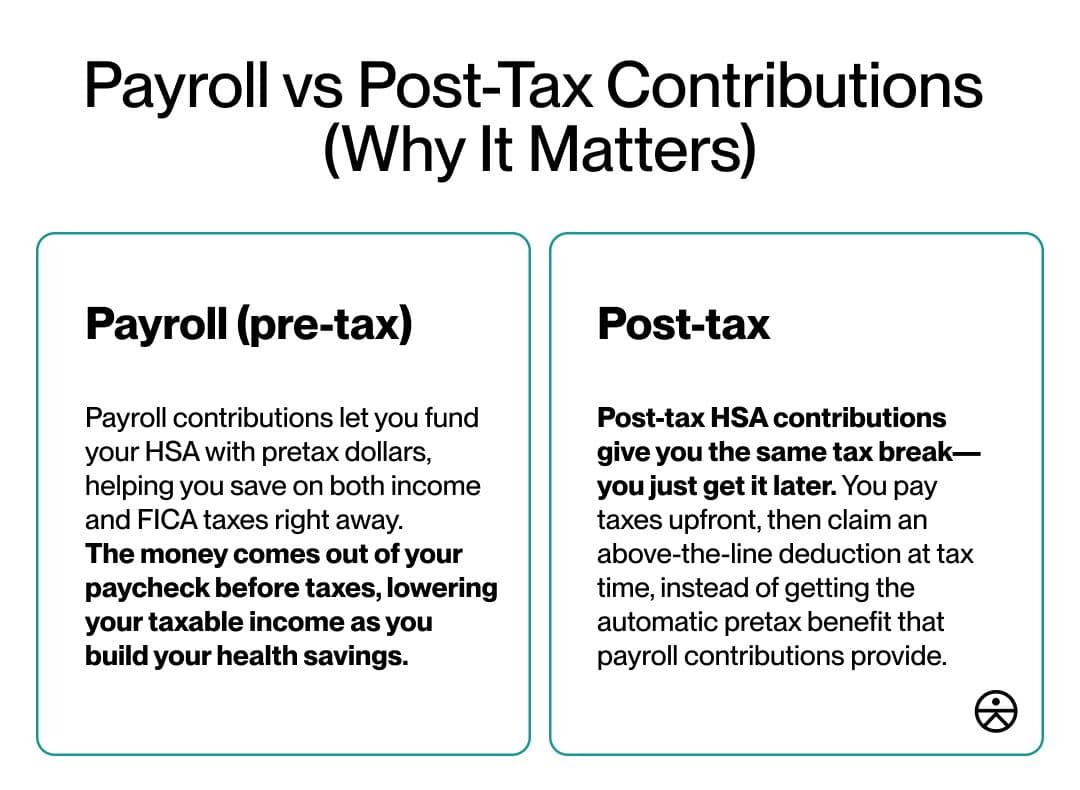Do Employer Contributions Affect Your HSA Limit?
Author:Kathleen Ferraro
Reviewed By:Katherine Janosz, MD
Published:
November 18, 2025

Short Answer: Yes—Employer Contributions Count Toward Your HSA Limit
Know Your Annual HSA Limit (What Sets Your Cap)
How to Do the Math (Step-By-Step)
Payroll vs Post-Tax Contributions (Why It Matters)
Common Edge Cases You Should Check
If You Over-Contribute (Fix It Fast)
Spending vs Contributing: Where an LMN Fits
How It Works with HSA/FSA (Truemed)
Key Takeaways
FAQ
Do Employer Contributions Affect Your HSA Limit?
If you’ve ever tried to figure out how much to put into your HSA, you know the math can get messy fast. Between employer “seed” money, payroll deductions, and IRS limits, it’s easy to wonder what actually counts. Here’s the deal: your employer’s contributions do count toward your annual HSA limit. That means you’ll want to keep tabs on both what you and your employer add throughout the year to avoid overcontributing (and getting hit with taxes later).
Health savings accounts (HSAs) are one of the smartest—and most flexible—ways to save for healthcare. They’re paired with high-deductible health plans and let you set aside pre-tax dollars to cover eligible medical expenses. That means qualified individuals can use their HSA for everything from prescriptions and copays to therapy or medical devices.
But here’s the tricky part: Figuring out how much you can actually contribute each year isn’t always straightforward. That’s because the IRS sets an annual contribution limit that includes every dollar that goes into your HSA, whether it’s from you, your employer, or even your spouse if you’re on family coverage.
So do employer contributions affect your HSA limit? In this guide, we’ll break it all down: how employer contributions factor in, how to plan your own deposits without overfunding, and how to use tools like Truemed to make the most of your pre-tax savings.
Short Answer: Yes—Employer Contributions Count Toward Your HSA Limit
Think of your HSA like a shared jar: no matter who drops money in, it all fills up the same space. Once that jar hits the cap, you’ve maxed out for the year.
In other words, any contribution made to your account counts toward your annual HSA limit—whether it’s from you, your employer, or someone else, according to Rami Sneineh, licensed insurance producer and vice president of Insurance Navy. If you go over that limit, the IRS treats the extra as taxable income unless you withdraw the excess before the tax-filing deadline.
Here’s what counts:
- Your own payroll deductions (pretax through your employer or post-tax deposits you make yourself)
- Employer contributions such as one-time “seed” funding, matching deposits, or wellness incentives
- Anyone else’s deposits (like a spouse or family member) that contribute directly to your account
And here’s what doesn’t count:
- Trustee-to-trustee transfers, which are direct transfers of money from one HSA provider to another. Because the funds never pass through your hands, they don’t count as new contributions
- Rollovers from another HSA, which simply move existing funds into your current account and don’t affect your annual cap

Know Your Annual HSA Limit (What Sets Your Cap)
Your HSA annual contribution limit depends on three main factors:
Your coverage type (self-only or family)
Your age (whether you qualify for the 55+ catch-up)
How long you’re eligible during the year
For 2025, the IRS HSA limits are $4,300 for self-only coverage and $8,550 for family coverage. In 2026, those limits will rise slightly to $4,400 and $8,750, respectively.
If you’re age 55 or older by the end of the calendar year, you can make an additional $1,000 “catch-up” contribution. This extra amount must go into your own HSA, not your spouse’s. If both you and your spouse are 55 or older and each have your own HSA, you can both make a catch-up contribution, adding up to $2,000 in extra tax-free savings between you.
Your type of coverage also affects how much you can contribute. If you move from individual to family coverage (or the other way around) during the year, your limit adjusts based on how many months you had each type of plan. The same goes if you gain or lose HSA eligibility partway through the year—for example, by changing jobs or switching to a health plan that doesn’t qualify.
There’s also something called the “last-month rule.” If you’re HSA-eligible on December 1, you’re allowed to contribute the full annual limit for that year—even if you were only eligible for part of it. The catch? You must stay HSA-eligible through December of the following year. If you don’t, the IRS will add back the excess amount as taxable income (plus a 10% penalty).
Because the HSA contribution rules can change depending on your situation, checking your eligibility before contributing—especially if you change jobs, health plans, or start Medicare—is key to staying compliant.
How to Do the Math (Step-By-Step)
Once you know your coverage type and annual limit, figuring out how much you can contribute is just simple subtraction. Here’s the process:
Start with your annual cap: Use the IRS limit that matches your coverage type—$4,300 for individual or $8,550 for family coverage in 2025.
Subtract any HSA employer contributions: This includes one-time “seed” money, monthly matches, or wellness incentives. For example, if your employer adds $1,000 to your HSA, your own maximum drops to $3,300 (if you have individual coverage), says Sneineh.
Subtract your spouse’s contributions (if applicable): If you have family coverage, your household shares one combined limit. For example, if your spouse contributes $2,000 to their HSA and you’re on a family plan, you can contribute up to $6,550 together before hitting the $8,550 cap.
Add any catch-up contributions if you’re 55 or older: You can add an extra $1,000 to your own HSA, and your spouse can do the same in theirs if they also qualify.
Adjust for mid-year changes: If you switch plans, change jobs, or lose eligibility partway through the year, you’ll need to prorate your contributions based on how many months you were eligible.
Once you’ve accounted for employer deposits, spouse contributions, and any eligibility changes, the remaining amount is your maximum employee contribution for the year.
“It's no stranger to me how some people are surprised once they reach the maximum limit earlier than expected,” says Chris Heerlein, a registered investment advisor representative and CEO of REAP Financial. “To avoid this, make it a habit to always review your HR portal or pay stub. That way, you can still adjust your own contributions before it's too late and before you are penalized for going over the limit.”

Payroll vs Post-Tax Contributions (Why It Matters)
How you contribute to your HSA affects when—and how—you get your tax savings.
Payroll (pretax) contributions are usually the most tax-advantageous way to fund your HSA, says Sneineh. “You avoid paying income and FICA taxes on those dollars, saving roughly 7.65% right away,” he explains.
In other words, the money comes straight out of your paycheck before taxes are applied. That way, you’re lowering your taxable income while building your health savings. These contributions show up on your W-2 under Box 12, Code W, alongside any employer deposits.
Post-tax contributions—money you deposit directly into your HSA outside of payroll—offer the same tax benefit, just on a delay. “Payroll contributions are automatically treated as a deduction from your taxable income,” explains Heerlein. “Post-tax contributions can still be deducted, but you have to wait until tax season to see the benefit.”
In plain terms, you’ll pay taxes upfront, then claim an above-the-line deduction when you file your return.
“Either way, you get the tax break,” says Heerlein. “It's just that payroll deductions are way simpler because you can benefit from it even without waiting until tax season.”
And both types of deposits count toward the same annual HSA max contribution, adds Sneineh. So if you use both methods in the same year, make sure your combined total doesn’t exceed the cap.

Common Edge Cases You Should Check
Even if you plan your HSA contributions perfectly at the start of the year, certain life or coverage changes can affect your eligibility and your limit. Here are a few situations to keep an eye out for.
1. Mid-Year Coverage or Job Changes
If you change jobs or switch to a different health plan, your HSA eligibility may shift mid-year, according to Sneineh. “These events require you to pro-rate your HSA annual contribution limit based on the number of months you were eligible,” he says.
Put simply, that means you can only contribute for the months you were covered by an HSA-eligible high-deductible plan. If your eligibility changes partway through the year, you’ll need to adjust your contributions so you don’t exceed your new limit.
2. Medicare Enrollment
Once you sign up for Medicare—even just Part A—you’re no longer allowed to add money to your HSA, says Sneineh. Because Medicare coverage can sometimes start retroactively for up to six months, Sneineh recommends stopping your contributions about six months before you apply to make sure you don’t go over your limit by accident.
3. FSA or HRA Participation
If you or your spouse has a general-purpose flexible spending account (FSA) or health reimbursement arrangement (HRA), you usually can’t contribute to an HSA at the same time, says Sneineh.
The good news? Some plan types still work together. A limited-purpose FSA (for dental and vision costs only) or a post-deductible HRA can let you keep adding to your HSA while still using those other benefits, according to Sneineh.
4. Both Spouses Have HSAs
If you and your spouse both have HSAs and are on family coverage, the combined contributions between both accounts can’t exceed the annual family limit. Each spouse, however, can still make their own $1,000 catch-up contribution after turning 55, as long as it’s deposited into their individual account, says Sneineh.
If You Over-Contribute (Fix It Fast)
If you accidentally put too much money into your HSA, don’t panic—it’s fixable. The key is to act quickly.
Start by calling your HSA provider and asking for a “return of excess contributions” (plus any interest those funds earned). Just make sure to do this before the tax-filing deadline—usually April 15—to avoid a 6% tax penalty on the extra amount.
Then, take a minute to check your payroll deductions for the rest of the year. If your employer added funds you weren’t expecting, or your plan changed mid-year, you can lower your future contributions to stay within the annual limit, says Heerlein.
Spending vs Contributing: Where an LMN Fits
Your HSA limit controls how much you can put in each year, but what you can spend it on is a different story. That’s where a letter of medical necessity (LMN) comes in.
An LMN is a document from a licensed provider that explains that a product or service is medically necessary for you. With one, you can often use your HSA or FSA dollars for items that aren’t automatically covered—like certain health tech, supplements, or fitness equipment that support a diagnosed condition.
It’s important to note that an LMN doesn’t raise your annual HSA contribution limit. It simply expands what counts as an eligible expense.
To stay compliant, keep copies of your LMN and receipts in case the IRS ever requests documentation.
How It Works with HSA/FSA (Truemed)
Truemed* helps you stretch your pre-tax dollars by simplifying how you spend on more eligible health products and services. Here’s how it works:
Check your eligibility: Start by taking Truemed’s online health survey.
Get a provider review: An independent licensed practitioner will review your responses. If you qualify, an independent clinician affiliated with our partner network will issue a Letter of Medical Necessity (LMN).
Pay the way you prefer: If you qualify, you can use your HSA or FSA card at checkout, or pay out of pocket and reimburse yourself later. Your LMN serves as proof that the expense qualifies under IRS guidelines. Check your plan details before purchase.
Keep everything in one place: Truemed securely stores your LMN and receipts, so your documentation is organized and easy to access if you ever need it for tax or reimbursement purposes.
*Truemed is for qualified customers. HSA/FSA tax savings vary. Learn more at truemed.com/disclosures.
Employer contributions count toward your HSA limit: No matter who adds the money—your employer, spouse, or you—it all goes toward the same annual cap.
Know your numbers: For 2025, the HSA limit is $4,300 for individuals and $8,550 for families, with an extra $1,000 catch-up if you’re 55 or older.
Watch for changes: Mid-year job switches, Medicare enrollment, or a spouse’s FSA/HRA can affect your eligibility and how much you can contribute.
Fix over-contributions fast: Contact your HSA provider before tax day to withdraw any excess and avoid penalties.
Use LMNs to maximize your savings: Use LMNs to confirm that your purchases qualify for HSA/FSA spending.
Let Truemed do the heavy lifting: From provider reviews to LMN storage, Truemed helps you get the most out of every pre-tax dollar without the paperwork headache.
Editorial Standards
At True Medicine, Inc., we believe better health starts with trusted information. Our mission is to empower readers with accurate and accessible content grounded in peer-reviewed research, expert insight, and clinical guidance to make smarter health decisions. Every article is written or reviewed by qualified professionals and updated regularly to reflect the latest evidence. For more details on our rigorous editorial process, see here.


